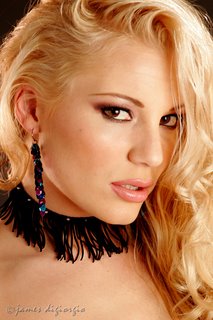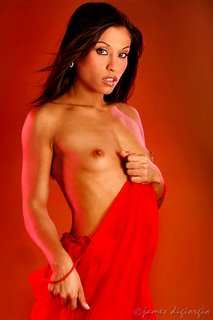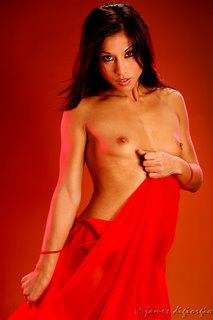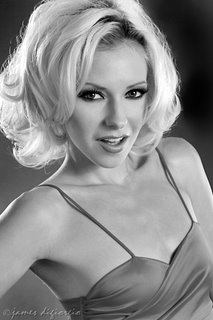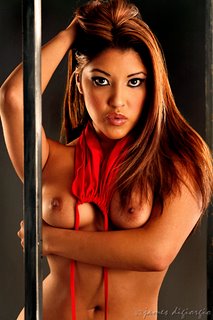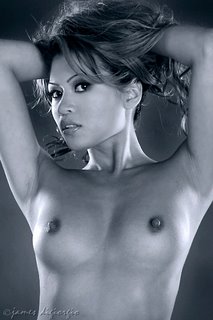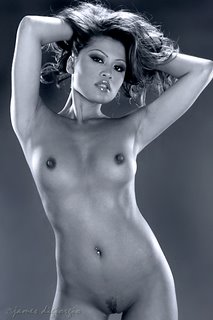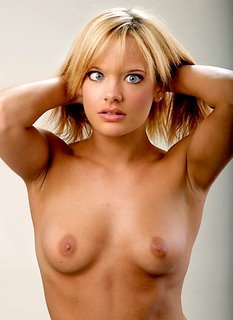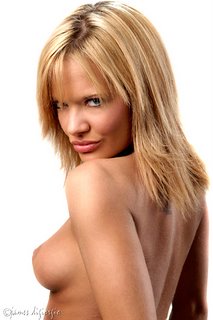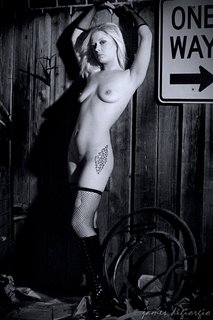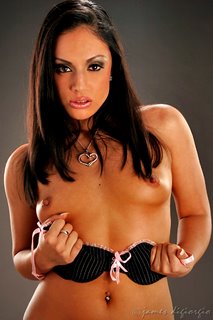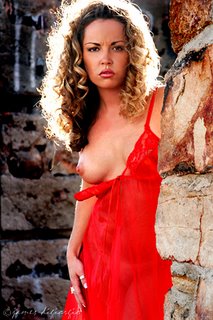
I hate it when things screw up right at the beginning. Yesterday was a good example.
Call time was scheduled for 10:00 A.M. at my friend's studio. I called my assistant for the day, Cippy, at about 9:00 and told him I'd be a little late as I realized I had to stop by my storage and retrieve some gear I would be needing. No problem was anticipated as a result of this: The model would be in make-up for about an hour-and-a-half and, once I arrived, I could be set-up and ready to shoot within a half-hour.
I arrived at the studio at about 10:30 and went right to the make-up room to see how things were going-- They weren't. The model, Cody, was sitting on the floor texting on her cell phone. Before I could say a word, Cippy came in and told me the MUA hadn't shown yet.
"Who's doing make-up?" I asked. (The MUA was booked by the client and I assumed Cippy was in contact with one of their people. Cippy, BTW, is technically one of the client's people as well. He's not an actual "photographer's assistant" but simply an extra pair of hands... sort of. I'll explain that later.)
Anyway, Cippy shrugged.
"Just great." I thought.
Cody, the model, took time-out from texting and offered a verbal hello. Just then, one of the client's "people" came in.

"Make-up will be here in a few minutes. She's only blocks away."
"What happened?" I asked.
She shrugged.
I grabbed Cippy and headed into the studio to get my gear out of my car and start setting it up.
About thirty minutes later I went back to the make-up room. Cody was still on the floor, still texting, and there was no MUA to be seen. Lea, the client's girl, was on the phone with Verizon arguing something about her cell phone bill.
"Where's make-up?" I asked.
Lea told the Verizon rep to "hold on a sec" and looked up. "She's not here yet."
"I can see that," I said. "Where is she?"
"She'll be here soon. There was a screw-up." And she went back to to speaking with Verizon.
I was becoming impatient. "What do you mean there's been a screw-up?"
"I'm on the phone," Lea said.
"I don't care what you're on. Where's the make-up girl? What do you mean there's been a screw-up?" Cody, the model, looked up at me and smiled meekly and sympathetically.
"Hold on again," Lea said into her phone and then looked up at me, obviously becoming perturbed that I was interrupting her phone conversation with Verizon. "She forgot to pencil this shoot in and she was on another set but now she's done and she's on her way," Lea quickly explained and returned her attention to Verizon.
None of this smelled right. I looked over at Cody but she was again intently texting. I went back to the studio to mess with my lights, realizing I wasn't going to get a straight answer.

Fast forward a bit and the MUA finally shows up at noon. Noon! two freakin' hours late! I started grilling her. "Why am I going to be going home two-hours later than I should be going home today?"
The MUA looked sheepishly at Lea. "I, uhh... forgot to pencil in this shoot."
It was becoming obvious now what probably happened: No one from the client's office booked the MUA and she was called at the last minute. I quickly realized further resistance was futile. I was just going to have to go with the flow even if the flow was pissing me off. I told Cippy to go find a Starbucks somewhere and get me some coffee. I went back into the studio to mess around with my laptop.
Two-hours later Cody was ready to go and we started shooting. Everything went smoothly from that point on. What'd'ya gonna do? Right? Get in the client's face for screwing up? Had it been me, of course, who had been the one tasked with booking the MUA, and had I forgot to do so, there would have been hell to pay.
Oh well. Just another day.
Model is Cody. MUA Kammi. Captured with Canon 5D w/85mm f/1.8 prime, ISO 100, f/5.6 @ 125th. Here's a shot of the lighting setup (below) for those of you who like seeing that stuff.

Oh, I should explain that part about Cippy "sort of" being a "pair of hands." Cippy was born with a birth defect. He only has three fingers on one hand and two on the other. It's amazing and remarkable to witness his dexterity in spite of his missing digits. I guess it's shameless of me to admit, but I sometimes refer to Cippy's hands as "claws" and I occasionally call him "Lobster Boy." (I've known Cippy for 6 or 7 years.)
I know, I know... it sounds cruel and insensitive of me. But Cippy has told me, numerous times, he not only thinks it's funny when I say that, but he'd rather have me bring attention to his "claws" from the start then have people pretend like nothing's wrong with his hands while constantly stealing weird glances at them. Ya see, once I refer to Cippy's hands as "claws" it diffuses all the weirdness anyone else on the set (who hasn't met Cippy before) might be feeling and, after they nervously giggle at my politically incorrect remarks, Cippy's hands become a non-issue. In fact, if we're shooting and I neglect to make my rude remarks, Cippy brings it up and, with a big grin on his face, eggs me on to make my crustacean comments at his expense. Go figure. And here's an interesting post script: Cippy is a favorite amongst many of the models for administering back massages with those claws. Apparently, and according to numerous models, Cippy's claws are perfectly designed for this and yield great back rubs. For some reason, Cippy never seems to mind being called upon to work the kinks out of these pretty naked model's backs.
 I once attempted reading Stephen Hawking's, "The Universe in a Nutshell." Well, there's nutshells and there's nutshells and the universe as a nutshell, as put forth by Hawking, the British theoretical physics guru, was beyond my abilities to comprehend. Color me stupid? Maybe.
I once attempted reading Stephen Hawking's, "The Universe in a Nutshell." Well, there's nutshells and there's nutshells and the universe as a nutshell, as put forth by Hawking, the British theoretical physics guru, was beyond my abilities to comprehend. Color me stupid? Maybe. 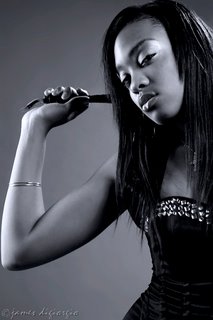 While I'm a big believer in renouned photographer, Andreas Feininger's, observation that, "A technically perfect photograph can be the world's most boring picture," I also believe technical competence plays a big role in achieving photographic perfection. (Assuming such a thing is achievable.)
While I'm a big believer in renouned photographer, Andreas Feininger's, observation that, "A technically perfect photograph can be the world's most boring picture," I also believe technical competence plays a big role in achieving photographic perfection. (Assuming such a thing is achievable.)
